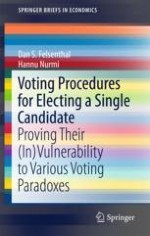This book deals with 18 voting procedures used or proposed for use in elections resulting in the choice of a single winner. These procedures are evaluated in terms of their ability to avoid paradoxical outcomes. Together with a companion volume by the same authors, Monotonicity Failures Afflicting Procedures for Electing a Single Candidate, published by Springer in 2017, this book aims at giving a comprehensive overview of the most important advantages and disadvantages of procedures thereby assisting decision makers in the choice of a voting procedure that would best suit their purposes.
